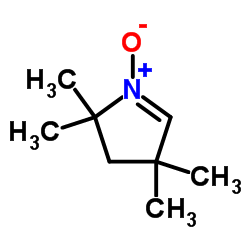Use of 3,3,5,5-tetramethyl-1-pyrroline-1-oxide spin trap for the continuous flow ESR monitoring of hydroxyl radical generation in the ischemic and reperfused myocardium.
M Culcasi, S Pietri, P J Cozzone
Index: Biochem. Biophys. Res. Commun. 164(3) , 1274-80, (1989)
Full Text: HTML
Abstract
A new approach for in vivo spin trapping and quantitation of oxygen-derived free radicals has been developed using a continuous flow high speed ESR detection system. Spin adducts of OH. were detected as 1:1:1:1:1:1 sextets (aN=15.2 G, aH=16.8 G, g=2.0055) in the isolated rat heart when perfused with 3,3,5,5-tetramethyl-1-pyrroline-1-oxide (40 mM) during a 10-min control pretreatment (14 ml/min) followed by 50 min of low-flow ischemia (1 ml/min), 30 min of global ischemia and subsequent reperfusion at 14 ml/min. The ESR signals appeared within 15-20 min of low-flow ischemia and grew moderately during the remaining 30 min at a rate of 2-6 nmoles of spin adduct released per minute. Post-ischemic reperfusion was characterized by a burst of spin adduct formation at 30 s-1 min, corresponding to 51.8 nmoles of spin adduct released between 30 s and 1 min.
Related Compounds
| Structure | Name/CAS No. | Molecular Formula | Articles |
|---|---|---|---|
 |
3,3,5,5-tetramethyl-1-pyrroline n-oxide
CAS:10135-38-3 |
C8H15NO |
|
The effect of myoglobin on the stability of the hydroxyl-rad...
1994-05-01 [Free Radic. Res. 20(5) , 327-32, (1994)] |
|
Oxidation of spin-traps by chlorine dioxide (ClO2) radical i...
1996-01-01 [Free Radic. Biol. Med. 20(6) , 837-41, (1996)] |
|
Spectral editing based on selective excitation and Lee-Goldb...
2006-06-01 [Solid State Nucl. Magn. Reson. 29(4) , 272-7, (2006)] |
|
Use of M4PO and oxygen-17 in the study on hydroxyl radical g...
1994-03-01 [Biochem. Mol. Biol. Int. 32(3) , 523-9, (1994)] |
|
Biological spin trapping. II. Toxicity of nitrone spin traps...
1995-11-01 [J. Biochem. Biophys. Methods 30 , 239-247, (1995)] |